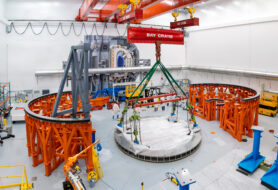Fusion companies pulled in a grand total of $2.64B over the last 12 months—a 178% increase growth-wise from the year before—but it’s still not enough to get over the finish line.
Every year, the Fusion Industry Association (FIA) surveys the breadth of the fusion industry to take stock. This year, the forecast shows sunny skies with a chance of clouds, and by that, we mean that the industry is confident that commercial fusion is less than a decade away, but significant attention and investment are needed to get there.
We know what you’re waiting for, so here are the key numbers up top:
- 53 total companies were surveyed, up from 45 last year and 23 in 2021.
- $9.77B has been invested in these companies to date, including the $2.64B added to the tally this year.
- $8.97B of that number has been private funding, and only $794.9M has come from the public sector.
- Eight companies entered the fusion landscape this year (and participated in the survey).
- 44% of the fusion workforce are engineers, 23% are scientists, and 33% fill other roles.
- 74% of the fusion workforce is male.
- 47% of the fusion companies surveyed are pursuing magnetic fusion, with the rest divided among a wide range of approaches.
How much more? The FIA asked respondents to self-report how much funding they still need to get to a pilot plant. The answers ranged dramatically, from ~$50M to $10B+, with a median response of $700M.
That number may not mean much, since the respondents are at various stages of funding and maturity. Still, the wide range of answers highlights the unknowns in getting fusion from its current experimental, R&D phase to a working commercial plant. The challenge isn’t just achieving breakeven and net gain, but also developing the supply chain, balance of plant, commercial relationships, and everything else necessary to build and run a plant.
If every company met its projected need, more than $77B in new investment would need to flow into fusion.
The government role: The FIA’s numbers reveal a comparatively poor showing from governments. This year, public investment totaled almost $360M, bringing total public investment in fusion to $794.9M. In a world where three fusion companies have each raised upwards of $1B each, those are rookie numbers.
Still, the FIA and respondents seem optimistic about the public sector’s role in supporting fusion research and commercialization.
“It is not only private funds that see long-term benefits to fusion,” the authors wrote. “Governments also recognize the economic advantages of nurturing a growing industry that will usher in jobs and expand supply chains.”
Lead Reporter of Ignition





